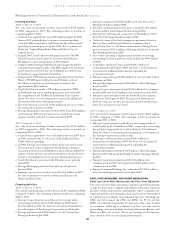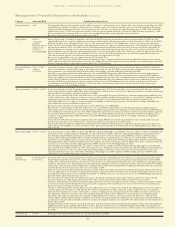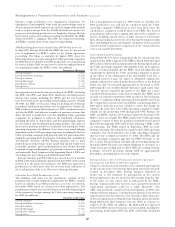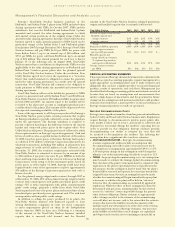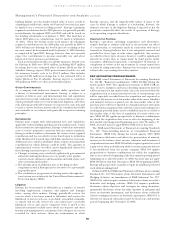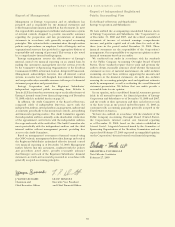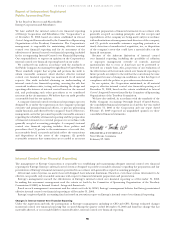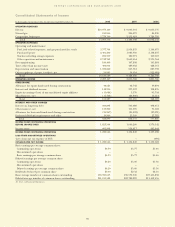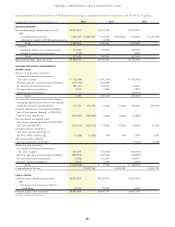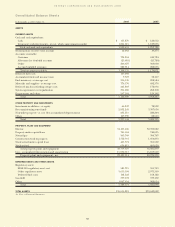Entergy 2008 Annual Report Download - page 50
Download and view the complete annual report
Please find page 50 of the 2008 Entergy annual report below. You can navigate through the pages in the report by either clicking on the pages listed below, or by using the keyword search tool below to find specific information within the annual report.
48
ENTERGY CORPORATION AND SUBSIDIARIES 2008
Management’s Financial Discussion and Analysis continued
48
to file testimony each month with the APSC detailing progress
toward development of successor arrangements, beginning in
March 2008, and Mr. McDonald has done so.
The APSC had also previously commenced investigations
concerning Entergy Louisiana’s Vidalia purchased power contract
and Entergy Louisiana’s then pending acquisition of the Perryville
power plant. Entergy Arkansas has provided information to the APSC
in these investigations and no further activity has occurred in them.
Entergy Mississippi Notice of Termination of
System Agreement Participation
In October 2007 the MPSC issued a letter confirming its belief
that Entergy Mississippi should exit the System Agreement in light
of the recent developments involving the System Agreement. The
MPSC letter also requested that Entergy Mississippi advise the
MPSC regarding the status of the Utility operating companies’
effort to develop successor arrangements to the System Agreement
and advise the MPSC regarding Entergy Mississippi’s position with
respect to withdrawal from the System Agreement. In November
2007, pursuant to the provisions of the System Agreement, Entergy
Mississippi provided its written notice to terminate its participation
in the System Agreement effective ninety-six (96) months from the
date of the notice or such earlier date as authorized by the FERC.
On February 2, 2009, Entergy Arkansas and Entergy Mississippi
filed with the FERC their notices of cancellation to effectuate the
termination of their participation in the Entergy System Agreement,
effective December 18, 2013 and November 7, 2015, respectively.
While the FERC had indicated previously that the notices should
be filed 18 months prior to Entergy Arkansas’ termination
(approximately mid-2012), the filing explains that resolving this
issue now, rather than later, is important to ensure that informed
long-term resource planning decisions can be made during the
years leading up to Entergy Arkansas’ withdrawal and that all of the
Utility operating companies are properly positioned to continue to
operate reliably following Entergy Arkansas’ and, eventually, Entergy
Mississippi’s, departure from the System Agreement. Entergy
Arkansas and Entergy Mississippi request that the FERC accept the
proposed notices of cancellation without further proceedings.
LPSC and City Council Action Related to the Entergy Arkansas
and Entergy Mississippi Notices of Termination
In light of the notices of Entergy Arkansas and Entergy Mississippi
to terminate participation in the current System Agreement, in
January 2008 the LPSC unanimously voted to direct the LPSC Staff
to begin evaluating the potential for a new agreement. Likewise, the
New Orleans City Council opened a docket to gather information
on progress towards a successor agreement.
Independent Coordinator of Transmission
In 2000, the FERC issued an order encouraging utilities to
voluntarily place their transmission facilities under the control
of independent RTOs (regional transmission organizations).
Delays in implementing the FERC RTO order occurred due to a
variety of reasons, including the fact that utility companies, other
stakeholders, and federal and state regulators have had to work to
resolve various issues related to the establishment of such RTOs.
In November 2006, after nearly a decade of effort, including
filings, orders, technical conferences, and proceedings at the
FERC, the Utility operating companies installed the Southwest
Power Pool (SPP) as their Independent Coordinator of
Transmission (ICT). The installation does not transfer control of
Entergy’s transmission system to the ICT, but rather vests with the
ICT responsibility for:
ngranting or denying transmission service on the Utility
operating companies’ transmission system.
n
administering the Utility operating companies’ Open Access
Same Time Information Systems (OASIS) node for purposes
of processing and evaluating transmission service requests and
ensuring compliance with the Utility operating companies’
obligation to post transmission-related information.
ndeveloping a base plan for the Utility operating companies’
transmission system that will result in the ICT making the
determination on whether costs of transmission upgrades
should be rolled into the Utility operating companies’
transmission rates or directly assigned to the customer
requesting or causing an upgrade to be constructed. This
should result in a transmission pricing structure that
ensures that the Utility operating companies’ retail native
load customers are required to pay for only those upgrades
necessary to reliably serve their needs.
nserving as the reliability coordinator for the Entergy
transmission system.
noverseeing the operation of the weekly procurement
process (WPP).
nevaluating interconnection-related investments already made
on the Entergy System for purposes of determining the future
allocation of the uncredited portion of these investments,
pursuant to a detailed methodology. The ICT agreement also
clarifies the rights that customers receive when they fund a
supplemental upgrade.
The initial term of the ICT is four years, and Entergy is precluded
from terminating the ICT prior to the end of the four-year period.
After the FERC issued its April 2006 order approving the ICT
proposal, the Utility operating companies made a series of compliance
filings with the FERC that were protested by various parties. The FERC
has accepted the compliance filings and denied various requests for
rehearing, although appeals of the FERC’s ICT orders are currently
pending in the U.S. Court of Appeals for the D.C. Circuit. As stated
above, SPP was installed as the ICT in November 2006.
In October 2006 the Utility operating companies filed revisions
to their Open Access Transmission Tariff (OATT) with the
FERC to establish a mechanism to recover from their wholesale
transmission customers the (1) costs incurred to develop or join
an RTO and to develop the ICT; and (2) on-going costs that will
be incurred under the ICT agreement. Several parties intervened
opposing the proposed tariff revisions. In December 2006 the
FERC accepted for filing Entergy’s proposed tariff revisions, and
set them for hearing and settlement procedures. In its Order, the
FERC concluded that each of the Utility operating companies
“should be allowed the opportunity to recover its start up costs
associated with its formation of the ICT and its participation in
prior failed attempts to form an RTO,” and also that the proposed
tariffs raised issues of fact that are more properly addressed
through hearing and settlement procedures. In June 2007 the
Utility operating companies reached a settlement-in-principle
with the parties to the proceeding and the FERC approved the
settlement in November 2007.
In the FERC’s April 2006 order that approved Entergy’s ICT
proposal, the FERC stated that the WPP must be operational within
approximately 14 months of the FERC order, or June 24, 2007, or
the FERC may reevaluate all approvals to proceed with the ICT. The
Utility operating companies have been working with the ICT and a
software vendor to develop the software and systems necessary to
implement the WPP. The Utility operating companies have filed status
reports with the FERC notifying the FERC that, due to unexpected
issues with the development of the WPP software and testing, the
WPP is still not operational. The Utility operating companies also
filed various tariff revisions with the FERC in 2007 and 2008 to
address issues identified during the testing of the WPP and changes
to the effective date of the WPP. On October 10, 2008, the FERC







